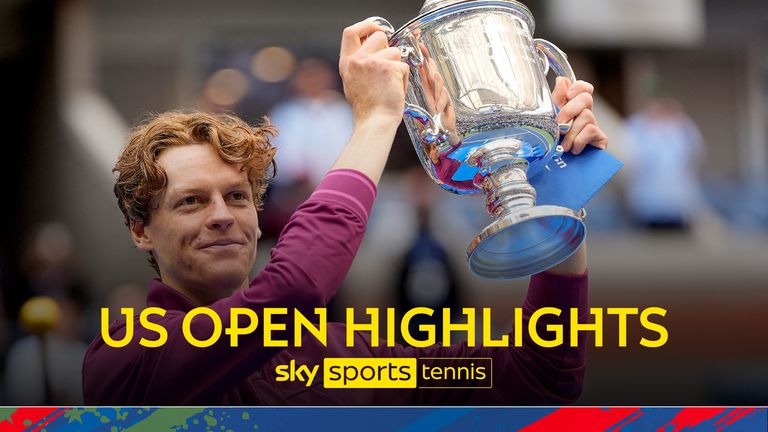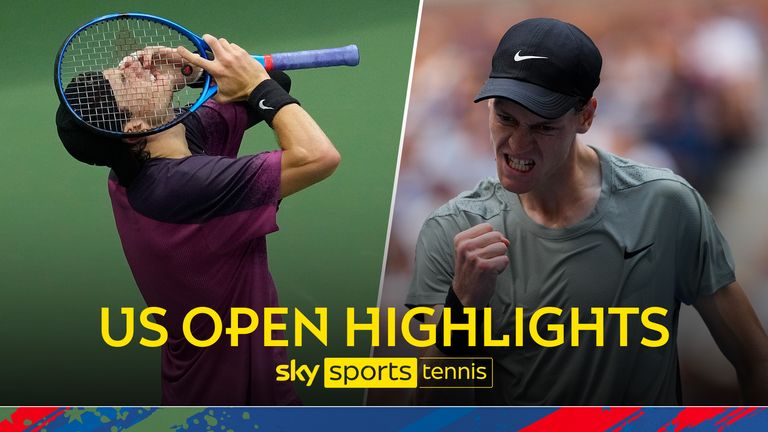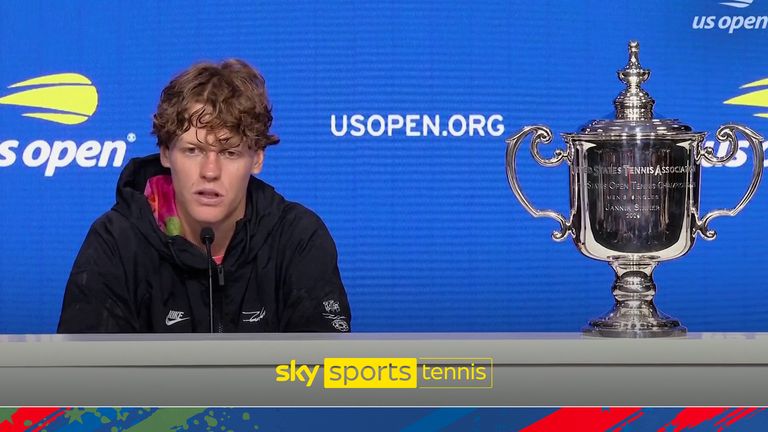[ad_1]
Following an appeal against Jannik Sinner being cleared of responsibility for testing positive for a banned substance, Sky Sports News’ Geraint Hughes analyses the situation facing men’s tennis world No 1.
How did Sinner test positive for a banned substance?
Sinner tested positive twice in March this year for a banned anabolic steroid called Clostebol which is derived from testosterone. In line with anti-doping processes throughout professional sport, Sinner provided a sample to anti-doping controllers. He first did so on March 10 during a tournament at Indian Wells. Eight days later in an out-of-competition test prior to the Miami Open the Italian also returned a positive test. Both Sinner’s tests amounted to less than a billionth of a gram, in essence trace amounts.
Sinner was informed of the positive test results and was initially provisionally suspended from tennis on April 4. He successfully appealed that suspension a day later and also another short suspension that lasted between April 17-20. Provisional suspensions can be overturned if an athlete demonstrates that a contaminated product was likely involved.
What was his explanation and why was he spared a ban?
After Sinner’s two positive tests, the International Tennis Integrity Agency (ITIA) took the case to an independent tribunal which was heard in August. The ITIA handles anti-doping and corruption in tennis.
Sinner successfully argued that the two positive tests had been as a result of contamination. The Italian and his legal team argued that his fitness trainer had purchased an over-the-counter spray called Trofodermin, widely used in Italy to heal cuts. Trofodermin contains Clostebol. Sinner’s physio Giacomo Naldi cut his finger in early March and used the spray for several days to treat the wound. He also continued his work with Sinner, massaging him and wrapping Sinner’s feet in bandages, Sinner argued that he was inadvertently contaminated by Naldi, who had not been wearing gloves when working on him. He also argued that he had no idea his trainer had bought Trofodermin or that Naldi had contaminated him with it.
At the independent hearing, three scientific experts said Sinner’s explanation was plausible. The ITIA accepted Sinner’s explanation that this was how he had returned two positive anti-doping tests with Clostebol present. The Independent Tribunal agreed. Technically, Sinner was found to bear ‘no fault or negligence’ for the failed tests. Because of that finding and ruling from an Independent Tribunal and the ITIA, Sinner was cleared of any wrongdoing and avoided a doping ban.
How did the world of tennis react to Sinner being cleared to play?
Mixed. The ATP backed Sinner and his team with a statement in August that said they were ‘encouraged’ by the Independent Tribunal/ITIA’s investigations, although they did reiterate the importance for players and teams to “take utmost care in the use of products or treatments. Integrity is paramount in our sport.”
Back in August several players criticised the decision not to ban Sinner. Nick Kyrgios didn’t hold back saying “Ridiculous, whether it was accidental or planned. You get tested twice with a banned substance… you should be gone for two years. Your performance was enhanced.” Denis Shapovalov commented “different rules for different players,” while legendary 7-time Grand Slam winner John McEnroe said it was “surprising” and “shocking.”
Why has the decision now been appealed?
Yes, it was appealed last week by WADA, the World Anti Doping Agency – technically it has launched its appeal against the ruling of ‘no fault or negligence.’ WADA believes that ruling is not correct under applicable rules. The ITIA, who originally investigated and passed on the investigation to an Independent Tribunal acknowledges WADA’s right to appeal this finding to the Court of Arbitration for Sport (CAS) under the WADA Code which means WADA has a final right to appeal all anti-doping decisions.
How long until Sinner receives a final decision on the appeal?
This is the big question to which there is no answer right now. WADA has stated their intention to appeal to CAS and have lodged an appeal with them on September 26.
However, CAS has a long list of cases to be heard. On their current listings that run up until a week before Christmas no date has been set for a hearing involving WADA, Jannik Sinner or the ITIA, so it could be that Sinner’s appeal at CAS might not be heard until 2025. This is not definite though as cases involving high profile athletes – as Sinner, the men’s World No 1 tennis player falls into that bracket – can potentially be fast tracked. As it stands though at the time of writing, no date for CAS to hear this appeal has been set in 2024. Sinner remains clear to play and if no CAS hearing or ruling is held before the Australian Open in January 2025, the Italian under the rules would be free to play in Melbourne.
How long could a ban be?
WADA is suggesting it wants to see a what it calls a period of ineligibility (most of us call it a ban!) of between one and two years for Jannik Sinner. What it is not seeking though is a disqualification of any results beyond which has already happened. Sinner’s placing at Indian Wells in March has already been removed, but regardless of the outcome of WADA’s appeal to CAS, they are not asking for Sinner’s US Open victory to be overturned. His 2024 US Open title remains his according to the nature of WADA’s appeal.
There is an acceptance among many that Sinner did not deliberately use Clostebol to enhance his performance and that the trace amounts of less than a billionth of a gram – accepted by a panel of three independent scientific experts – do not constitute cheating. However WADA’s appeal is based around enforcement of what they see as the rules for all sportsmen, sportswomen, their coaches and entourages.
Strict liability means that ultimately it is the athlete who is responsible for what goes into or onto their bodies and that substances which are clearly highlighted as banned on the WADA prohibited list must not be used by any athlete. If they are, then a ban from sport is what WADA will seek in most cases. Clearly the fact WADA has lodged an appeal already with CAS means they feel Sinner’s explanation is not good enough to exonerate him from strict liability.
What’s coming up on Sky Sports Tennis in October?
- Shanghai Masters – ATP 1000 (October 2-13 – Jack Draper in action)
- Wuhan Open – WTA 1000 (October 6-12 – Emma Raducanu in action)
- Almaty Open, Kazakhstan – ATP 250 (October 14-20)
- Stockholm Open, Sweden – ATP 250 (October 14-20)
- European Open, Antwerp – ATP 250 (October 14-20)
- Japan Open, Osaka – WTA 250 (October 14-20)
- Ningbo Open, China – WTA 500 (October 14-20)
- Erste Bank Open, Vienna – ATP 500 (October 21-27)
- Swiss Indoors, Basel – ATP 500 (October 21-27)
- Guangzhou Open, China – WTA 250 (October 21-27)
- Toray Pan Pacific Open Tennis, Tokyo – WTA 500 (October 21-27)
Sky Sports+ has officially launched and will be integrated into Sky TV, streaming service NOW and the Sky Sports app, giving Sky Sports customers access to over 50 per cent more live sport this year at no extra cost. Find out more here.
[ad_2]
Source link



